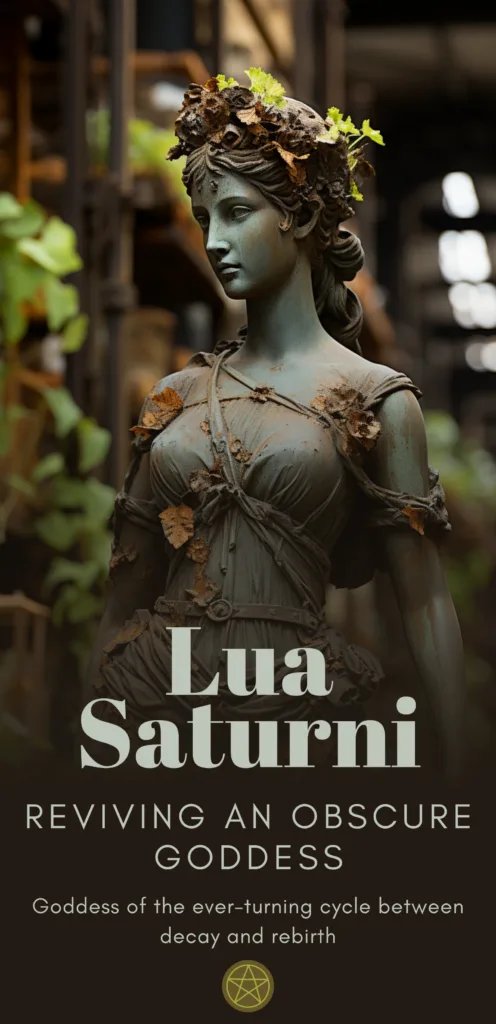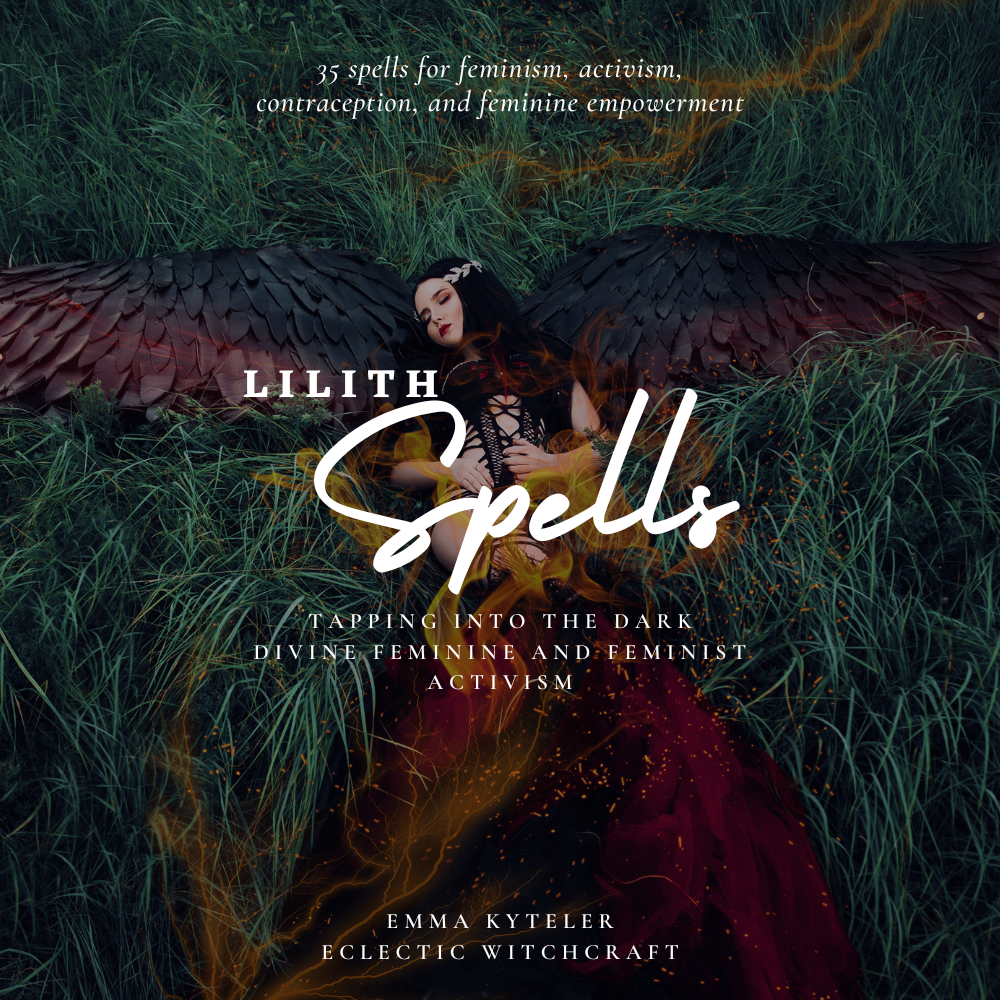Please note that posts on this site may contain affiliate links
The ancient Roman goddess known as Lua Saturni, Lua Mater, or Mother Lua is an incredibly obscure figure in mythology. Very little information exists about her in ancient sources, leaving modern practitioners with more questions than answers. Her mysterious nature makes reviving her worship today an exercise in using unverified personal gnosis.
With so little concrete evidence about who she was and what she represented, modern witches seeking to honor Lua Saturni must piece together clues and fill in the blanks themselves. Though this requires guesswork and imagination, the obscurity of this goddess also presents fascinating opportunities.
Witches today can breathe new life into Lua Mater and explore her attributes using intuition and experimentation.
- Who is Lua Saturni?
- Symbols and Offerings for Lua Mater
- Candle Colors for Lua Saturni
- Planetary Days and Hours for Lua Saturni
- What Lua Saturnia Can Help With
- Invoking Lua Saturni in Rituals
- Lua Saturni and the Seasons
- Lua Saturni in Mythology
- Signs from Lua Saturni
- Working with Lua Saturni
- Modern Magical Correspondences for Lua Saturni
- A Modern Prayer to Lua Mater
- Sources
For witches inclined toward the destructive powers of magic, Lua Saturni offers intriguing possibilities. She is associated with war, plague, and the sacrificial burning of enemy weapons. This indicates her connection to curses, combat magic, and protection spells.
Yet she is also tied to agriculture, linking her to fertility and abundance. Lua Mater embodies the cycle of sowing and reaping, growth and decay.
For witches who walk between the light and dark aspects of magic, between nurturing seeds and blighting crops, Lua Saturni is a fitting goddess to call upon. Her paradoxical nature echoes the contradictions within us all.
By examining the few clues that ancient sources provide about Lua Mater, we can begin piecing together an image of this enigmatic goddess. While definitive information is lacking, remnants offer inspiration for a modern revival of Lua Saturni.
Using correspondences, candle colors, planetary days, and magical offerings, today’s witches can recreate her worship in a way that resonates for the present age.
- Lua Saturni is an incredibly obscure ancient Roman goddess
- Very little concrete information exists about her in ancient sources
- Modern practitioners must fill in the blanks using intuition and guesswork
- Her association with both fertility and destruction is paradoxical
- She offers interesting possibilities for witches who walk between light and dark magic
Who is Lua Saturni?
The true origins and meaning behind the goddess Lua Saturni are shrouded in mystery. Her name may derive from the Latin word “luo” meaning to loosen, dissolve, or destroy. This connects with her role as a goddess of decay and blight.
Some scholars link her name to the Latin word for plague – “lues.” This ties Lua Saturni to disease, calamity, and misfortune. As a goddess who brought ill fate upon enemies, she may have been invoked to curse opponents with sickness or famine.
Lua Saturni is associated closely with the Roman god Saturn. She is sometimes referred to as “Lua Saturni” meaning Saturn’s Lua. This may indicate she was paired with or subordinate to Saturn at certain times.
The Roman historian Livy recorded soldiers sacrificing captured enemy weapons to Lua after victories in battle. This ritual sacrifice hints at her connection to war and the spoils of war.
Lua Saturni’s association with agriculture also surfaces through her ties to Saturn – a god of sowing, planting, and harvest. She may have been worshipped for her ability to either bless crops or blight them.
Some scholars propose Lua Saturni was actually Ops, the wife or sister of Saturn in Roman mythology. Ops was a goddess of fertility, abundance, and sowing like her husband Saturn. So Lua may have been an epithet or local iteration of Ops.
The sparse hints about Lua Saturni from history present her as a complex goddess of plague and fertility, war and agriculture. She embodies the ever-turning cycle between decay and rebirth. For witches today, these contradictions offer a chance to redefine and revive this obscure goddess through personal exploration.

Symbols and Offerings for Lua Mater
Lua Saturni’s associations with war and agriculture give us hints about appropriate offerings and symbols to use when honoring her. Her connection to rust and decay indicates that rusted items or things in rusty red, orange, and brown tones could please her.
Iron objects like nails, farm tools, and swords would also be suitable representations of her rustic, warlike attributes. Weapons taken as trophies from personal conflicts or competitions make appropriate gifts for Lua Mater, especially if they are burned as offerings. She was said to appreciate the sacrificial burning of enemy arms after battles or contests.
As a goddess tied to plague and blight, disease and decay, offerings that represent entropy and dissolution are also appropriate. Rotting flowers, spoiled food, and diseased plants or dead animals can be given to Lua Saturni.
However, as an agricultural goddess, fresh crops and living plants are also suitable for decorating her altar and leaving as tributes. She embodies both growth and ruin, so honoring one side of her attributes necessitates honoring the other. Giving her healthy grain, seeds, and living plants brings completeness to her paradoxical nature.
Symbols and Offerings for Lua Mater
- Rusted items
- Iron objects like nails, tools, and swords
- Weapons taken as trophies, especially if burned
- Rotting flowers, spoiled food, diseased plants
- Healthy crops, seeds, and living plants
Candle Colors for Lua Saturni
When dressing candles or selecting colors for Lua Saturni’s altar, rusty red, burnt orange, and earthy brown are obvious choices. Red candles connect to her ferocity in war and evoke Mars energy. The passion, aggression, and drive represented by red candles align with the warlike side of this obscure goddess.
Orange candles relate to her associations with fire and rust through their bright, hot color. They represent flames and destruction.
Brown candles relate to Lua Mater’s earthy, agricultural side, reflecting ripening crops, planted seeds, and cycles of decay and rebirth.
Other colors can amplify the magical energies of red, orange, and brown candles used in Lua Saturni’s worship. Combining red and black candles boosts the power of combat magic, hexes, and protection spells.
Adding black to orange candles enhances their magical influence over enemies. Mixing brown and green brings abundance and fertility. White candles lend purification when blended with red, orange, or brown.
Combinations of these colors allow magic workers to fine-tune the candles used in rituals and spellwork dedicated to Lua Mater and her changeable attributes.
Candle Colors for Lua Saturni
- Rusty red – evokes war, Mars energy
- Burnt orange – represents fire and rust
- Earthy brown – reflects ripening crops and planting seeds
- Red and black – boosts power of combat magic and protection
- Orange and black – enhances power over enemies
- Brown and green – brings abundance and fertility
- White – adds purification

Planetary Days and Hours for Lua Saturni
The few ancient sources that mention Lua Saturni connect her most strongly to the gods Mars and Saturn. Therefore, performing rituals and magic in honor of Lua Mater on the days and hours ruled by Mars and Saturn amplifies their effectiveness.
Mars rules Tuesday, and Saturn rules Saturday. The hours of these days shift on a weekly basis, so magical practitioners must consult planetary hour charts to determine the correct timing.
Mars hours promote courage, passion, confidence, and victory in conflicts or competitions. Saturn’s hours are optimal for neutralizing enemies, establishing boundaries, dispelling evil, and protection.
Calling on Lua Saturni during Mars or Saturn hours on their respective days is ideal, but other combinations can also be effective.
Mars hours on a Saturday dedicated to Saturn magic provides an interesting blend of energies suited for combat and defense.
Similarly, Saturn hours on a Tuesday boost martial magic by adding disciplined focus and an eye for strategy. Experimenting with these planetary days and hours can help devotees of Lua Mater discover which combinations amplify her magic in ways that align with their goals.
Planetary Days and Hours for Lua Mater
- Mars weekday – Tuesday
- Saturn’s day – Saturday
- Consult hourly planetary charts
- Mars hours – promote courage, passion, victory in conflicts
- Saturn’s hours – neutralize enemies, dispel evil, protection
- Mars hours on Saturday – blended energies for combat and defense
- Saturn hours on Tuesday – adds discipline and strategy to martial magic
What Lua Saturnia Can Help With
Lua Saturni’s ferocity in war indicates her usefulness to soldiers seeking victory and protection in battle. Warriors can call on her assistance through rituals, prayers, and offerings before going into combat. She can aid in the defeat of enemies and turn the tides of war in one’s favor. For those in peacetime, Lua Mater’s support can help vanquish personal foes.
Hexes cast in her name carry force and finality. Her aid manifests through ruination of enemies, just as she was said to blight crops and bring plague.
However, Lua Saturni also rescues devotees from the horrors of war and bloodshed. She cleanses and purifies those stained by battle through the rituals of surrendering enemy weapons to her sacrificial flames.
This hints at Lua Mater’s role in cleansing evil and adversity from someone’s life. Her fiery destruction of malevolent energies and entities can aid magical practitioners plagued by dark forces. Lua Saturni brings purgation and renewal through annihilation, reducing harmful influences to ashes so that goodness can rise in their place.
This obscure goddess clearly grants power over enemies, whether embodied in human adversaries or evil spirits that threaten harm. Yet she also governs the sowing and harvesting of crops, indicating her patronage over abundance and nourishment.
With such contradictions integral to her character, Lua Mater resists simplistic assumptions about her areas of influence. She encompasses life and death, war and peace, curse and cure. There are evils she can infect and blessings she can bestow. By honoring her many facets, witches can receive Lua Saturni’s well-rounded blessings.
- Victory and protection in war or battles
- Defeat of personal enemies and foes
- Hexes and curses
- Cleansing and purification from bloodshed and evil
- Removing dark forces and malevolent entities
- Gaining power over adversaries
- Nourishment and abundance of crops
Invoking Lua Saturni in Rituals
When calling on the power of the goddess Lua Saturni in rituals, rustic decor and fiery offerings help create an energized space. Her altars may feature iron nails, farming tools, and harvested crops. Lit candles in red, orange, and brown call her rustic colors.
Offerings can include burnt bread, roasted grains, and destroyed weapons or effigies of enemies. Chants may praise her paradoxical nature and call for her aid in decay or nourishment. Dancing and drumming raise energy to summon her presence.
Ritual fires that burn wood, paper, or effigies offer destruction she enjoys. Calling the quarters with rusty ritual blades or athames aligns the circle with her martial energy.
Her shrines can be adorned with cypress, thorns, and sunflowers. By incorporating her symbols and domains, rituals invoke the full force of this complex goddess.
Lua Saturni and the Seasons
Lua Saturni’s contradictory agricultural and warlike aspects align with different points on the Wheel of the Year. Her fertility side connects to spring planting rituals and autumn harvest ceremonies. Her fiery, warlike side suits the combustive energy of midsummer. Samhain honors her role in decay and blight. Specific sabbats include:
- Imbolc – blessing seeds & agricultural tools
- Beltane – fertility rituals & planting
- Litha – fire rituals & combating enemies
- Lughnasadh – blessing grains & first harvest
- Mabon – honoring the final harvest
- Samhain – recognizing decay, letting go
Lua Saturni in Mythology
While Lua Saturni remains an obscure figure in mythology, some clues connect her to other Roman deities. Her epithet as “Lua Saturni” links her directly to the Titan god Saturn. As father of the gods, Saturn may have been her original consort before Jupiter took power.
Some equate Lua with Ops, Saturn’s sister-wife who shared his agricultural aspects. Lua’s association with Mars through war links her to the violent god of battle. Her connection to agricultural blight and disease relates her to Robigus, god of crop disease.
Though details are scarce, her bonds to Saturn, Mars, Ops, and Robigus hint at a destructive yet nourishing goddess who dispels enemies but aids worshipers.
This comprehensive book delves into the dual energies of Aphrodite, empowering you to manifest your desires in matters of the heart and personal conflicts. Explore the depths of love and war magic as you learn advanced techniques such as sigil creation, candle magic, and divination to deepen your connection with Aphrodite and gain insight into romantic situations. Discover a diverse collection of spells that range from attraction and deepening connections to conflict resolution and protection. Embrace the dark aspects of love while honoring the nurturing and healing energies of Aphrodite, and learn to wield baneful magic with respect and caution. With its reader-friendly layout and comprehensive features, "Aphrodite of Love and War: A Spell Book for Romantic Warfare" is your ultimate companion on a transformative journey of self-discovery and empowerment.
Signs from Lua Saturni
This mysterious goddess communicates through rustic and natural means. Finding unusual rust patterns on iron, seeing foxes or locust swarms, or encountering cypress or wormwood may signal her presence. Dreams of fire, battle, or crop blights reveal her messages.
Thunderstorms during quiet periods connect to her unpredictable nature. Bloody omens, weaponry, and ravaged farms or fields indicate she wants offerings. Productive gardens, abundant grain, and strong livestock signify her goodwill.
Defensive instincts, wariness, and subconscious anger or aggression can mean she wants to be honored with confrontation rituals. By learning her subtle language, devotees can interpret when and how Lua Saturni speaks.
Signs from Lua Saturni and What They Mean
- Finding rust on iron objects or structures – Lua may be calling attention to the need for cleansing, renewal, or removal of a corrupting influence
- Noticing foxes repeatedly – Foxes are cunning tricksters and Lua may be asking you to think strategically or deceptively to outwit an adversary
- Locust swarms – This sign of impending crop destruction reflects Lua’s ability to blight harvests and signifies a need to make offerings to appease her
- Encountering cypress or wormwood – These plants sacred to Lua indicate her presence and mark a location to make offerings or rituals in her honor
- Dreams of fire or war – Lua may be invoking her fiery, martial powers through such dreams or asking you to take bold, decisive action
- Dreams of decimated crops or famine – Lua could be sending a warning about possible misfortunes related to livelihood, finances, or abundance. Take protective measures.
- Thunderstorms during clear weather – The unexpected chaos of such storms signals Lua’s involvement. A disruptive change or confrontation may be imminent.
- Omens involving blood or weapons – Lua may desire destructive offerings and rituals to honor her warlike aspects
- Finding ruined farms, ravaged crops or fields – Lua is showing her powers of devastation and likely seeking appeasement
- Productive gardens, abundant grain harvests – These signs indicate Lua’s goodwill and blessings upon you and your sources of sustenance
- Strong instincts for self-defense, protectiveness – Lua is stoking your warrior spirit and readiness to defend what is precious
- Increased subconscious feelings of anger or aggression – Lua may want rituals of confrontation to productively channel this energy
- Rusted antiques suddenly breaking – Lua might be highlighting the need to clear out and remove the old to make way for new growth
Pay attention to patterns and contexts around these signs to properly interpret Lua Saturni’s messages. Over time, discernment grows as you learn her symbolic language.
Working with Lua Saturni
When integrating obscure Lua Saturni into one’s practice, caution and discernment is key. Seek understanding through research, ritual, meditation, and observation over time.
Be mindful of her paradoxical attributes and do not treat her solely as a “dark” or “light” goddess. Balance destructive offerings like burnt weapons with generative ones like ripe crops. Keep records to notice her patterns, preferences, and responses.
Check intentions so ego and anger do not distort her purpose. Understand her ethics regarding war, fertility, and the cycle between.
Envision her not as a weapon to wield, but as a teacher revealing necessary destruction that enables life. Work respectfully with this complex goddess and she can become a lifelong ally.
Modern Magical Correspondences for Lua Saturni
When adapting such an ancient, ambiguous goddess for modern practice, creative liberties are necessary. Through meditation, ritual, and unverified personal gnosis, today’s magic workers can develop their own unique correspondences and associations for Lua Mater.
Her connections to Saturn, Mars, fire, war, and agriculture act as a framework, but the gaps are wide. Anything relating to iron, rust, soil, seeds, flames, weapons, blight, and plague aligns with the bits of definitive lore.
Beyond this core, Lua Saturni’s mythology invites innovation. Fire agate, carnelian, rust opal, and pyrite crystals carry her rustic radiance. Sunflowers, thorned plants, cypress, wormwood, and blighted crops suit her.
Tasers, pepper spray, swords, knives, and firearms symbolize her combat magic. Iron supplements, iron skillets, rusty antiques, and farming equipment represent her grounded, rural origins. Incense like dragon’s blood and tobacco amplify her harsh side, while wheatgrass and dried grains honor her nurturing side.
With so little solid information on this goddess, modern magic practitioners are free to color outside the lines. Trusting one’s intuition and experimenting through trial and error allows relationships with Lua Saturni to develop organically.
Keeping record of signs, omens, and results provides insight into her nature. Interacting with Lua Mater is a reciprocal process of giving and receiving. Offerings grant glimpses of her preferences, and dreams or meditations reveal her evolving significance. Through continuous relational growth, devotees will discover the unique Lua Saturni that speaks to them.
Modern Magical Correspondences
- Metals: Iron, steel, copper, bronze
- Minerals: Hematite, pyrite, iron oxide, mica, rust
- Colors: Rusty red, burnt orange, brown, black
- Plants: Thorn vines, cypress, wormwood, blighted crops, sunflowers, corn, oats, rye, millet
- Incense: Tobacco, dragon’s blood, cedar
- Oils: Black pepper, cinnamon, clove
- Crystals: Carnelian, brecciated jasper, fire agate, hematite, sunstone
- Altar decor: Rusted antiques, iron nails, farm tools, swords, daggers, spears, bullets, war medals
- Food offerings: Fresh bread, grain, beans, corn, wine, ale, rotten offerings
- Astrology: Mars, Saturn
- Tarot: The Tower, Three of Swords, Five of Swords
- Runes: Tiwaz, Uruz, Kaunaz
- Deities: Mars, Saturn, Bellona, Nerio, Ops
- Creatures: Dogs, foxes, locusts
- Weather: Drought, wildfires, lightning storms
- Direction: South
- Sabbats: Litha, Mabon
- Moon phases: Waning crescent, new moon
- Days: Tuesday, Saturday
A Modern Prayer to Lua Mater
Lua Saturni, ancient goddess of contradictory attributes,
Your paradoxical nature teaches balance and wholeness.
You bless the warrior’s sword and nurture the farmer’s seed with equal grace.
We honor the many faces you have shown across the ages, obscured but unforgotten.
We make offerings in tribute to your sovereignty of battlefields and wheat fields alike.
May these gifts reflect the multiplicity you represent.
As we give to you, we ask that you give to us in return.
Lend strength and strategy to overcome our adversaries,
That we may know the glory of righteous victory.
Lend abundance and vitality to our crops,
That we may know the joy of plentiful harvest.
Send adversity far from us,
And bless our destiny as you see fit.
We honor you, Lua Mater, goddess of decay and renewal,
Of broken chains and broken blades.
Awaken in us your paradoxical power.
Io Lua Saturni!
Delve into the mystical world of "Lilith Spells: Tapping Into The Dark Divine Feminine And Feminist Activism," a powerful grimoire that will guide you on a transformative journey through the realms of Lilith, the first wife of Adam, feminist icon, and demon goddess. Unearth the secrets of this enigmatic figure, who embodies the essence of feminine power, independence, and rebellion against patriarchal oppression. Includes 35 unique spells.
Sources
Lua Mater: Fire, Rust, and War in Early Roman Cult




